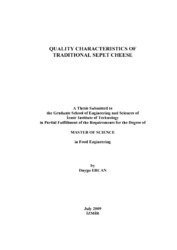Please use this identifier to cite or link to this item:
https://hdl.handle.net/11147/3780Full metadata record
| DC Field | Value | Language |
|---|---|---|
| dc.contributor.advisor | Korel, Figen | - |
| dc.contributor.author | Ercan, Duygu | - |
| dc.date.accessioned | 2014-07-22T13:52:21Z | - |
| dc.date.available | 2014-07-22T13:52:21Z | - |
| dc.date.issued | 2009 | - |
| dc.identifier.uri | http://hdl.handle.net/11147/3780 | - |
| dc.description | Thesis (Master)--Izmir Institute of Technology, Food Engineering, Izmir, 2009 | en_US |
| dc.description | Includes bibliographical references (leaves: 103-109) | en_US |
| dc.description | Text in English; Abstract: Turkish and English | en_US |
| dc.description | xiii, 112 leaves | en_US |
| dc.description.abstract | Investigation and registration of traditional foods contributes to the improvement of economy and the continuation of important elements of a nation.s culinary heritage, culture. Various types of traditional cheese are present in different shape, color, taste in the world. Sepet cheese is one of the traditional cheeses produced in the Aegean region. In this study, chemical, physical, microbiological, organoleptic, and aroma characteristics of traditional sepet cheeses were investigated. The changes in the quality characteristics were examined during production and ripening periods. The natural lactic acid bacteria flora of sepet cheeses during production and ripening was identified with phenotyphic methods. As a result of chemical analysis, average chemical characteristics of traditional sepet cheeses were found as 54.33 %±5.17 total solid content, 0.82±0.05 water activity, 25.11 %±2.86 fat content, 5.58±0.43 pH, 28.99 %±2.12 protein content. According to microbiological analysis of sepet cheeses, average total aerobic, lactococci, lactobacilli, enterococci, psychrotrophic bacteria, Staphylococcus aureus, yeast, mold, coliform bacteria counts were 7.64±1.18, 7.38±1.10, 7.38±0.99, 6.99±0.99, 5.37±1.15, 1.25±1.72, 3.22±0.25, 0.95±0.96, 2.72±1.82 log cfu/g, respectively. During descriptive profile analysis, traditional sepet cheeses were described with free fatty acid, cooked, creamy, whey, animal like, sulfurous aromatic descriptives with high salty basic taste. Free fatty acids were found to be the most abundant volatile compounds of sepet cheeses and had the highest aroma intensities in volatile fraction. According to phenotypic identification, isolates were closely related to Lactococcus lactis subsp. lactis, Lactobacillus casei spp. rhamnosus, L. plantarum, heterofermentative Lactobacillus spp., Streptococcus thermophilus, Leuconostoc spp., Enterococcus durans and E. faceium. | en_US |
| dc.language.iso | en | en_US |
| dc.publisher | Izmir Institute of Technology | en_US |
| dc.rights | info:eu-repo/semantics/openAccess | en_US |
| dc.subject.lcc | SF272.25 .E658 2009 | en |
| dc.subject.lcsh | Process cheese | en |
| dc.subject.lcsh | Cheese--Turkey | en |
| dc.subject.lcsh | Cheese products | en |
| dc.subject.lcsh | Cheese--Microbiology | en |
| dc.title | Quality Characteristics of Traditional Sepet Cheese | en_US |
| dc.type | Master Thesis | en_US |
| dc.institutionauthor | Ercan, Duygu | - |
| dc.department | Thesis (Master)--İzmir Institute of Technology, Food Engineering | en_US |
| dc.relation.publicationcategory | Tez | en_US |
| dc.identifier.wosquality | N/A | - |
| dc.identifier.scopusquality | N/A | - |
| item.openairecristype | http://purl.org/coar/resource_type/c_18cf | - |
| item.cerifentitytype | Publications | - |
| item.fulltext | With Fulltext | - |
| item.languageiso639-1 | en | - |
| item.grantfulltext | open | - |
| item.openairetype | Master Thesis | - |
| Appears in Collections: | Master Degree / Yüksek Lisans Tezleri | |
Files in This Item:
| File | Description | Size | Format | |
|---|---|---|---|---|
| T000787.pdf | MasterThesis | 1.03 MB | Adobe PDF |  View/Open |
CORE Recommender
Page view(s)
364
checked on Apr 28, 2025
Download(s)
188
checked on Apr 28, 2025
Google ScholarTM
Check
Items in GCRIS Repository are protected by copyright, with all rights reserved, unless otherwise indicated.